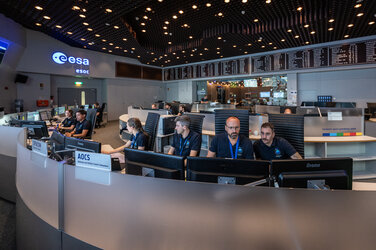Zero Debris Charter - Frequently Asked Questions
1. What is the Zero Debris Charter?
At the Ministerial Conference of 2022, ESA was encouraged by its Member States to implement “a Zero Debris approach for its missions; and to encourage partners and other actors to pursue similar paths, thereby collectively putting Europe at the forefront of sustainability on Earth and in space, while preserving the competitiveness of its industry”. The Zero Debris Charter initiative is ESA’s response to the second part of this mandate.
Through the open and collaborative development of a document combining high-level principles and space sustainability targets for 2030, the Zero Debris Charter aims to activate the space community in Europe and beyond towards ambitious collective action on space debris mitigation and remediation, with the goal of achieving a Zero Debris future by 2030.
2. How was the Zero Debris Charter drafted?
The Charter was drafted through an open and collaborative process. As advertised on ESA channels at various steps of the initiative, any interested entity was welcome to join the drafting efforts. More than a hundred registered their interest, with around 40 actively engaging in the co-development.
During the initiative’s kick-off webinar on 10 July 2023, ESA proposed a draft zero, opening a period (July-August 2023) during which approximately 200 comments were received from Europe and beyond. On this basis, four co-development workshops were held in ES HQ (Paris, 4 September), online (19 and 29 September) and at ESA ESTEC (Noordwijk, 16 October).
On average, 35 organisations were represented and active during the workshops.
3. Is it an ESA Zero Debris Charter or a European Zero Debris Charter?
It is the Zero Debris Charter. ESA, through its Protect Accelerator, has acted as a facilitator of the open and collaborative drafting process. ESA as a participant in the community was represented during the workshops by its Head of Space Safety, Holger Krag, as one voice among many. Quentin Verspieren, Protect Accelerator Coordinator, acted as independent chair.
The Zero Debris Charter is neither owned nor written by ESA, but is the result of an open and collaborative process. Participation was not restricted to European space actors, making it a truly global endeavor.
4. Is the Zero Debris Charter legally binding? Will it impact ESA procurement or impose strict requirements on the European industry?
The Zero Debris Charter itself is not legally binding. It is a technically driven, community-building instrument agreeing on common goals. As written in the Charter, each signatory will contribute to the achievement of the jointly defined targets to the extent of its abilities and constraints.
The idea is to drive collective efforts towards a Zero Debris future, not to impose constraints on space actors. As part of ESA's own approach to Zero Debris, regular updates are made to its own Space Debris Mitigation Policy, which make the Agency's internal ESA Space Debris Mitigation Requirements a required standard for its own activities.
Through this policy the Space Debris Mitigation Requirements are also integrated in ESA procurements. Two revisions are already foreseen in 2026 and 2030, to ensure the full implementation of a Zero Debris approach for all missions entering the design phase after 2030.
5. What makes the Charter different from other similar initiatives?
The Zero Debris Charter is innovative in many ways. It was developed through an open and collaborative process, to which any interested entity could contribute on an equal basis. Compared with other initiatives primarily focussing on one category of space actor, the Zero Debris Charter’s co-development partners included the whole spectrum of space actors in Europe and beyond: legacy and new space industrial players, space agencies, universities, international organisations, non-profit foundations, etc.
The document itself is innovative as it includes both high-level principles and very concrete and measurable space sustainability targets. Finally, the most important is that the Zero Debris Charter is not the end but the starting point for intense community work with major ESA contributions.
6. How will the Charter lead to a Zero Debris future?
The Zero Debris Charter’s primary purpose is to build a community of proactive space actors around an ambitious although realistic vision of space sustainability for 2030. What matters is how we initiate powerful, collective, capacity-building efforts, including important ESA contributions, to achieve the Zero Debris Charter’s jointly defined target and a make the Zero Debris future a reality.
As a first concrete step, the Community has come together for multiple workshops to develop and publish the Zero Debris Technical Booklet. As a living document, the Technical Booklet identifies technologies that will contribute to the goal of Zero Debris by 2030. Essentially, the Booklet forms a technical Zero Debris 'to-do list'.
7. How will ESA contribute to the Zero Debris Community?
ESA has announced numerous contributions to the Zero Debris Charter initiative. Some are directly included in the text of the Zero Debris Charter: organising the signing process, maintaining a public list of signatories and providing regular opportunities for exchange in the Zero Debris Community’s collective progress towards the achievement of the jointly defined targets for 2030.
In addition, ESA, through its Space Safety Programme, facilitates the crowd-sourced Zero Debris Technical Booklet and includes further collaborative elements in ESA’s internal roadmap to ensure smooth collaboration processes for the Zero Debris Community.
8. How does the Zero Debris Charter differ from ESA's Zero Debris approach?
The Zero Debris approach is ESA’s own internal commitment for all its missions entering design phase after 2030 not to leave any debris in valuable orbits. ESA has already started a step-by-step implementation of this approach through the ESA Space Debris Mitigation Requirements that are being applied to its missions. It is not only the commitment to a Zero Debris future that is required, to fulfill the ambition there is the need for varied technology development as well as the building of a broad community supporting the clean and sustainable use of space without causing any further space debris. ESA is actively contributing to developing the technologies and enabling European industry to be ready for a Zero Debris future.
9. Who can sign the Zero Debris Charter?
As written in paragraph 3.2 of the Charter, “any entity demonstrating a strong commitment to advancing space safety and sustainability” can sign the Charter and join the Zero Debris Community, “without requiring the agreement of existing partners”. Concretely, interested entities should register their intent to sign the Charter using this form on the ESA website. After a follow-up exchange with ESA to check the validity of the registration, the name of the entity will be added to the public list of entities having registered their intent and subsequently to the list of signatories.
10. Why sign up to the Zero Debris Charter?
Beyond signalling your support to an ambitious initiative, with the objective and potential to have a profound impact on debris mitigation and remediation worldwide, by signing the Charter you would join the Zero Debris Community that will implement collective capacity building towards 2030 and beyond.
For questions on joining the Charter, contact Quentin Verspieren, Protect Accelerator Coordinator at quentin.verspieren@esa.int.
For media request, contact media@esa.int.















 Germany
Germany
 Austria
Austria
 Belgium
Belgium
 Denmark
Denmark
 Spain
Spain
 Estonia
Estonia
 Finland
Finland
 France
France
 Greece
Greece
 Hungary
Hungary
 Ireland
Ireland
 Italy
Italy
 Luxembourg
Luxembourg
 Norway
Norway
 The Netherlands
The Netherlands
 Poland
Poland
 Portugal
Portugal
 Czechia
Czechia
 Romania
Romania
 United Kingdom
United Kingdom
 Slovenia
Slovenia
 Sweden
Sweden
 Switzerland
Switzerland






































